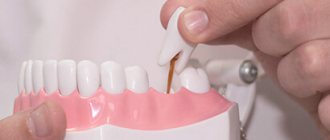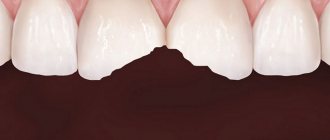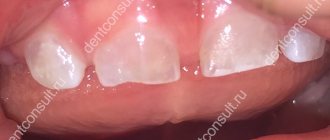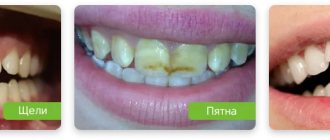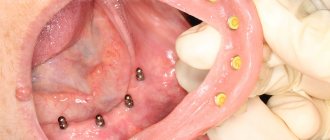Author: Brodsky Sergey Evgenievich Deputy Chief Physician, Candidate of Medical Sciences in the specialties: dentistry and medical microbiology A broken tooth is the cause of discomfort during eating, which can lead to the development of inflammatory processes in the hard and soft tissues of the tooth, root and gum . Therefore, if a defect is detected, you should immediately consult a dentist, who will select the correct method for restoring the tooth.
Causes of tooth fracture
Part of a tooth can chip or break as a result of exposure to internal and external factors. The first group of reasons include:
- pathologies associated with disruption of intrauterine development of surface and hard tissues of the tooth;
- metabolic disorders associated with impaired absorption of calcium, magnesium and phosphorus, provoked by rickets suffered in childhood, the use of diuretics, and poor nutrition;
- diseases of the digestive tract, accompanied by changes in the acidity of saliva, which has a destructive effect on tooth tissue.
A tooth in the gum can break under the influence of a number of external factors, including:
- injuries to the skull and jaw during a fight, road accident;
- tooth injury during dental procedures;
- eating solid foods;
- thermal injury due to the simultaneous consumption of cold and hot food and drinks;
- advanced carious processes;
- incorrect structure of the dentition.
The crown part of the front tooth is broken
If a front tooth is partially fractured, veneers or crowns can be used.
Veneers restore tooth function, protect dentin from external influences, and also the aesthetics of a smile. Treatment is only suitable for slightly damaged teeth. If the dental crown is severely damaged, the dentist will suggest installing a ceramic crown.
Crowns are placed on the remaining part of the tooth after grinding and preparing the surrounding area around the damaged tooth. If a significant part of the tooth has broken off, then to securely fix the crown it will be necessary to make a stump inlay, and in this case the tooth will have to be depulped (remove the nerve and fill the root canal).
The main stages of tooth restoration using a crown:
- Drawing up and agreeing on a treatment plan;
- Next, the doctor grinds the tooth down for a crown;
- Taking a silicone impression. The impression is sent to the dental laboratory. Based on the impression, the technicians reconstruct a plaster model of the teeth, and the technician will model the crown on it;
- When the crown is made, it is tried on and, if there is no discomfort, fixed on the stump.
To close the aesthetic defect, until the permanent crown is made, I install temporary plastic crowns on the patient, which can be made either in the laboratory or in the clinic.
Material for making dental crowns . Front teeth are a person’s calling card. When smiling, in conversation, every person involuntarily exposes his front teeth. Their beauty and health attract their interlocutor. This is why choosing the type of crown for teeth in the smile area is so important. The main types of permanent dental crowns are metal-ceramics, metal-free ceramics and ceramics with a zirconium dioxide frame. The most preferable material, from an aesthetic point of view, for the manufacture of dental crowns for the front teeth is metal-free ceramics e.max or feldspathic ceramics, also ceramics with a zirconium dioxide frame.
Dentists' recommendations
If a tooth is cracked, you can save it, but you should make an appointment with your dentist right away. The sooner professional help is provided, the less likely there are complications.
Before visiting a doctor, you should adhere to the following recommendations:
- the load on the injured tooth is completely eliminated;
- take only soft or ground food of medium temperature;
- Every hour, rinse your mouth with antiseptic agents, saline solutions or herbal decoctions.
Experts strongly advise against touching a damaged tooth with your fingers or tongue. You should not loosen it or try to use any popular recommendations. When a tooth is cracked, it can only be saved by going to the dentist.
Restoration method – bridge prosthesis
Dental bridges got their name for their visual resemblance to a bridge - they are a structure of two crowns, between which artificial teeth are located.
Crowns are placed on your own ground teeth. The advantages of bridges are good aesthetics and reliable fixation. Dental bridges are permanent, making them very comfortable. This type of dental prosthetics requires several visits to the doctor. First, impressions are made, from which a temporary prosthesis is made in a denture laboratory or clinic - the patient will not experience discomfort when communicating due to the absence of a front tooth. At the same time, the dental clinic prepares the supporting teeth. They are ground to install a crown to a shape that is optimally suitable for this, and most often (but not always) they are depulped. After the grinding is completed, impressions are taken again, from which dentists make a permanent prosthesis, and after that it is installed on the supporting teeth and fixed with cement.
The main disadvantage of a bridge is the need for depulpation and grinding of healthy supporting teeth. In addition, its installation, which leads to an uneven load on the alveolar bone and its thinning in the area of the missing tooth..
What Causes Injury?
The main reason why tooth crown damage occurs is weakened enamel.
In such cases, microcracks and chips often form, which subsequently lead to a crown fracture. But even strong teeth can be injured under strong mechanical stress, however, this usually happens simultaneously. The reason for the weakening of the enamel can be:
- poor quality dental treatment;
- deficiency of calcium, phosphorus and fluorine;
- violation of nutrition rules;
- constant exposure to food acids;
- disruption of the pancreas with uneven release of acidity;
- the effect of different temperatures when eating food (hot-cold);
- jaw injuries.
With weakened teeth, a crack can also occur as a result of the habit of chewing hard objects or foods, nails, packaging, etc.
Dentists warn that those at greatest risk are patients who have had prior dental treatment with pulp removal or a filling placed on a large, diseased crown cavity.
Restoration method - one-stage implantation immediately after root removal
Single-stage implantation of a front tooth involves immediately installing an implant into the socket after tooth extraction. For this type of implantation, special dental implants with aggressive threading and a high degree of primary stabilization are used. On the same day, immediately after implantation, a temporary plastic crown is installed. This implantation allows you to solve two problems - removing a broken tooth root and closing a cosmetic defect. In addition, the method allows you to save a little, because... Some manipulations are not performed (for example, the gum former is not installed).
After 3-4 months, when osseointegration of the implant is complete, permanent crowns are installed. Just as in the case of conventional crowns, from an aesthetic point of view, the best solution for the front teeth is the use of ceramic crowns and, accordingly, abutments. It is preferable to install the crown on a zirconium dioxide abutment, then in any type of lighting the crown will not stand out from the general row of teeth. In our opinion, this option for restoring a broken front tooth is the most optimal.
Light filling on a pin – what are the advantages of the method?
A post filling is considered a reliable replacement material when a dentist is restoring a fractured unit. A titanium or fiberglass pin is inserted into the root canal, after which the coronal part is restored with a composite material. Among the disadvantages of the method is the potential risk of root fracture, since the pin fails under pressure, as well as shrinkage of the filling and the development of secondary caries under it.
Unfortunately, teeth restored in this way do not last forever. After 3–5 years, the dentist will have to change the filling or, due to global destruction of the crown, perform prosthetics/implantation.
How do you know if you have a broken tooth?
This question is not as strange as it may seem at first glance. If only the enamel is affected, a person may not understand that his tooth is damaged or underestimate the degree of threat to his body. Therefore, you need to pay attention to the signs:
- Sharp, sharp pain is a classic symptom. However, as already mentioned, this sign alone is not enough to draw conclusions.
- Damage to the integrity of the crown. That is, upon visual inspection, it is usually noticeable that the crown is chipped or cracked. Also, when touched with the tongue, the crown begins to feel different. As a rule, there is a feeling of chipping and sharp edges.
- Violation of fixation. A damaged tooth often begins to loosen.
- Damage to the mucous membranes and (or) gums, bleeding in adjacent areas. This may be due to both the impact itself and the fact that tooth fragments damaged soft tissue.
- Change in crown color. Most often, the crown turns pink, although other options are possible.
It is problematic to diagnose a tooth root fracture on your own. Therefore, it is better not to make hasty conclusions, but simply make an appointment with a doctor. Our clinic can see you urgently if you describe the situation. Plus, we are always ready to quickly help a patient with acute pain.
Types of damage
There are several types of dental injuries with fractures. The classification sign is the depth and degree of injury.
Enamel chip or microcrack
In this case, the integrity of the upper layer of hard tissue is compromised - it cracks, or a small fragment separates. Usually such problems are invisible and do not cause discomfort. These are minor defects that can be quickly treated, but people do not rush to the dentist with them, which is a serious mistake.
What to do if part of a front tooth or a piece of a back tooth chips or falls out? It is important to visit a dental clinic as soon as possible. Damaged structures will become a place for the spread of pathogenic microflora, which will provoke the development of caries and other diseases. In addition, the load when chewing food will increase significantly, so half of the crown may fall off at any moment.
Chip with dentin fracture
Dentists classify this type of damage as moderate. Symptoms may be pronounced or completely absent. If the dentin layer is not restored, the unit will gradually crumble and soon fall apart. In addition, the smile will become unattractive, especially if a piece of an incisor is missing.
Deep fracture to the pulp tissue with exposure of the nerve
This is a severe injury with serious symptoms such as bleeding and severe pain. Even strong painkillers help dull unbearable sensations only for a short time. The crown may be missing half or more. If you are late with medical intervention, the risk of infection, inflammation and other pathological processes that are difficult to treat increases significantly.
What types of fractures can there be?
The most common diagnosis is a tooth root injury. In this case, the maxillary row is more often susceptible to this type of fracture, since due to its anatomical location it takes on the entire force of the blow. To establish such a diagnosis, radiography is indispensable. A crack or fracture of dentin is usually detected on the lower jaw.
By direction they distinguish:
- Vertical
- the most serious injury that often occurs during dental treatment. It affects the deep structures of the tooth, including the pulp and gum.
- Transverse (horizontal)
- depending on the level at which the fracture occurred, loosening of the tooth is observed.
- Splintered
- multiple fractures in different places, while the fragments can intersect or shift.
- Oblique
- the fault occurs at an angle.
A tooth fracture in which the pulp chamber is exposed is called complete. Without damage to the pulp - invisible. Often the injury is accompanied by subluxation of the jaw. They are divided into complete and incomplete. With a strong blow, the root of the tooth may become immersed in the socket (impacted dislocation). In this case, surgical intervention is necessary.

